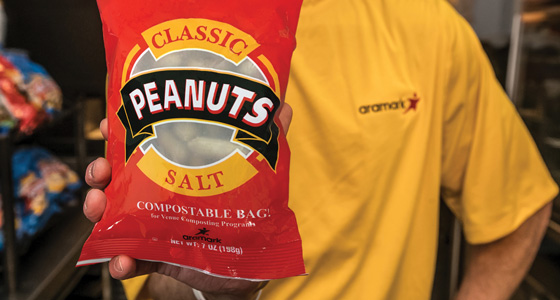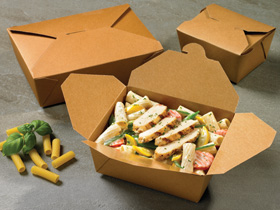The Complexities of Compostable Food Packaging
PACKAGING
Despite being a fraction of the $800 billion global packaging market, compostable packaging is gaining in popularity. Compostable packaging is processed into decayed organic material called compost, which can be used to fertilize soil. The nuanced role of compostable packaging, standards, and types of compostable packaging coalesce to achieve more sustainable food packaging.
Composting: Closed-Loop Versus Open-Loop
Compostable food packaging functions in two scenarios: closed-loop and open-loop. A closed-looped system (such as a stadium, university, business, etc.) is characterized by the control of food and packaging inputs as well as waste outputs. When food packaging is used, disposed of, and sorted for composting in a closed environment, compostable packaging can be a sustainable choice. To realize the sustainability benefit of compostable packaging, it is critical to connect the entire packaging value chain from compostable package production to the venue where it is used and collected with food scraps and ultimately composted in an industrial compost facility. An example of a successfully integrated value chain is at Arrowhead Stadium, the home of the Kansas City Chiefs. Foodservice provider Aramark provides peanuts from Hampton Farms in a compostable bag made of ecovio by BASF; a compostable heat seal layer; and NatureFlex by Futamura USA, a reverse-printed barrier layer laminated with Epotal by BASF, which is a compostable adhesive. A local composter, Missouri Organics, processes the compostable waste from this stadium. Zero-waste events, in which 90% of venue waste is either recyclable or compostable, are popular in many university stadiums.
Important challenges of closed-loop venues are that not all composters can process all the various types of compost or feedstocks and not all venues have a regional composter. Common composting feedstocks that may or may not be accepted for composting can include yard waste, industrial food from factories, residential food from homes, or food from venues. Compostable packaging for food-soiled applications is necessary to prevent contamination at the composting facility. For this reason, a composter is the most important stakeholder to ensure a successful end of life. The compostable packaging industry works throughout the value chain to ensure that compostable packaging can be processed in the region where the packaging is used.
Curbside collection of organic waste, an open-loop method, is in its infancy, and only 4% of U.S. households have access to curbside composting. The use of compostable packaging where compostable packaging collection and processing facilities do not exist is akin to availing recyclable containers before the existence of consumer education on recycling and infrastructure for collecting and recycling containers. Despite this, retailers such as PCC Community Markets, ASDA, and Delhaize are transitioning to compostable packaging as part of sustainability initiatives. In the European Union, separate collection of bio-waste, including yard waste, food/kitchen scraps, and in some cases, compostable packaging, will be mandatory by the end of 2023. It is likely that the infrastructure for collection and processing of compostable packaging will grow as successful localized programs show the benefits of organic waste diversion and the value of compost.
In the absence of infrastructure to collect and process compostable packaging, home composting is often seen as an option. However, effective home composting of compostable packaging requires consumers to closely monitor their composting to ensure aerobic biodegradation. Proper moisture, oxygen, microbe activity, temperature, and pH are required to support the composting of packaging. For this reason, the efficacy of home composting varies, and packaging leaders are understandably wary of promoting the composting of packaging at home. Thus, compostable packaging is best handled in well-managed industrial facilities. As is the case with recycling, proper collection and sorting of organic waste is key for efficient and effective composting. Minimizing contamination is critical and requires clear consumer education to sort compostable, recyclable, waste-to-energy incinerable, landfillable, and reusable packaging; appropriate infrastructure must also be in place for proper collection.
The Sustainability of Compostable Polymers and Standards
A life cycle analysis (LCA) assesses the environmental impact of an entire packaging value chain from raw material extraction (from renewable sources such as trees and plants) to disposal (landfill, compost, or incineration) after potential reuse or recycling. An LCA assessment includes environmental indicators such as energy demand, greenhouse gas emissions, and water consumption. More recently, it has been used to assess the sustainability of compostable packaging. Although standardized LCA methods (ISO 14040 and ISO 4044) and simplified toolkits serve as general guides, the strengths and limitations of these LCAs for determining the overall sustainability of a package must be considered when interpreting the results.
In LCAs of compostable packaging, the positive value of compost in replenishing carbon losses from soil, reducing the need for nitrogen-based fertilizers, and retaining water need to be included. Since packaging preserves food, comprehensive LCAs for food and for packaging are essential tools to become a more sustainable food industry. Moreover, preventing food waste with adequate packaging is often more sustainable than diverting more food waste into compost (EPA 2014; Wikström et al. 2018)
Besides food hygiene and safety requirements, additional performance criteria are used to assess whether compostable packaging is fully consumed by microbes along with food waste. First, the rate and amount of disintegration and biodegration are measured by tracking how much carbon from the package is converted to carbon dioxide in the disintegration process. Then, the toxicity of resultant compost is quantified. Importantly, these specifications define which products are safely consumed by microbes at a satisfactory rate under controlled conditions, and certification bodies provide assurance that claims regarding compostability are valid.
To ensure that materials are compostable, certification bodies around the world assess whether products meet the standards by using approved testing methods. In North America, the specifications for industrial compostability of packaging are ASTM D6400 and ASTM D6868; the Biodegradable Products Institute certifies resins, intermediates, and finished packaging systems to these standards. Global standards such as the Canadian CAN/BNQ 0017-088 and European EN 13432 mirror the ISO and ASTM standards. While there are methods to measure the degradation of home-compostable and marine-compostable packaging, these methods are not standardized.
Sources of Compostable Food Packaging
To be used as a food packaging material, compostable packaging needs to align with existing food-industry requirements for conditions of use and types of food. Functionally, compostable packaging would need to be a drop-in solution or be viable in an adjusted value chain. As a drop-in solution to replace existing food packaging, compostable packaging needs to match relevant chemical and mechanical properties. This involves fine-tuning compostable packaging to match the oxygen and water-vapor transmission rates necessary to protect food from lipid oxidation, microbial growth, water loss, or nutrient degradation. By modifying the value chain, many compostable packaging structures with less water vapor and oxygen barrier properties can be more effectively used. Compostable packaging is also assessed for compatibility with existing packaging machinery, in the distribution system, and with consumers. As with other packaging materials, blends, layers, coextrusion, or copolymers of compostable materials with different properties must be developed to protect food and create a finished package that is compostable. For example, ecoflex by BASF is blended with polylactic acid (PLA) to produce multiple grades of BASF’s ecovio, which is suitable for films, coatings, thermoforming, and injection molding.
Compostable packaging can be fossil-derived or derived from trees, sugar cane, corn, and other renewable resources (Robertson and Sand 2018). The environmental impact and material properties of compostable packaging vary with its source. There is interest in packaging made from foods such as seaweed, mushrooms, pea starch, whey proteins, and carrot peels; there is also interest in edible packaging. However, packaging made from food does not necessarily mean it is compostable nor a sustainable use of resources.
Paperboard used in packaging is primarily derived from cellulose fiber, which is processed and then coated. When compostable coatings and additives and inks are used, often an entire paperboard-based package can be composted.
For example, the Bio-Plus Terra II recycled-content paperboard-based container by WestRock is coated with a compostable polymer so that the whole package is compostable. Some examples of compostable polymers used in food packaging materials include PLA, polyhydroxyalkanoates, starch, polybutylene succinate, and polybutylene adipate
terephthalate.
Olivia Kannas, a student at Drake University, assisted with the collection of information.
REFERENCES
EPA. 2014. Food Waste Management in the United States, 2014 (report).
Roberston, G.L., and C. Sand. 2018. “Bio-derived polymers for food packaging.” Food Technol. 72(7):120–122.
Wikström, F., K. Verghese, R. Auras, et al. 2018. Packaging Strategies That Save Food: A Research Agenda for 2030. J. Ind. Ecol. 23(3):532–540.






